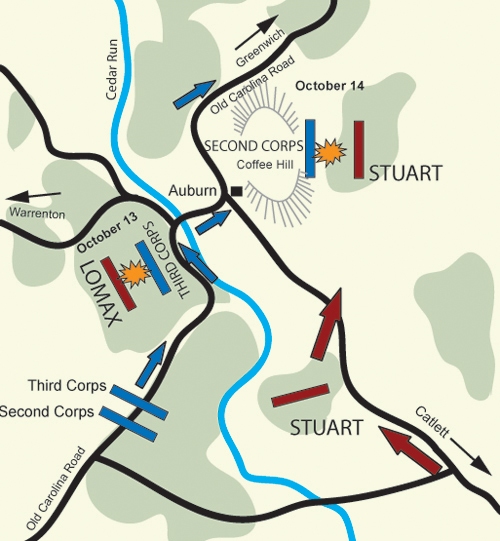Introduction
After the Battle of Gettysburg, July 1-3, 1863, Union General George G. Meade was criticized for not destroying Confederate General Robert E. Lee and his army of Northern Virginia; instead, Lee slipped away from Meade, crossing the Potomac River back into the Confederacy. That fall, Meade planned an offensive to attack Lee’s position behind the Rapidan River in Orange County, Virginia.
Emboldened when Lee dispatched part of General James Longstreet’s Corps to the western theatre of war, Meade defeated Lee’s forces in Culpeper, Virginia, at the Battle of Culpeper Courthouse. Meade, however, soon found his role reversed when, on September 24, he too dispatched troops to the west. Lee, learning of Meade’s weakened force, seized the initiative and attempted to turn Meade’s right flank, forcing Meade to withdraw along the Orange and Alexandria Railroad.
Although both Meade and Lee achieved victories in this campaign, the overall result was inconclusive. Lee was frustrated that his initiative had not met more success, even though his troops pushed back Meade forty miles and denied Federal troops valuable railroad access. In the end, the Bristoe campaign accomplished little, and both armies survived to fight another campaign.
Battles Of Auburn I & II
Date: October 13 – 14, 1863
Result: Inconclusive
Troops Engaged: 20,000 US; 32,000 CS
Casualties: 78 US; 85 CS
In the late afternoon on October 13, Confederate cavalry under General Lunsford Lomax encountered the Union Third Corps as it marched north along the Old Carolina Road to Greenwich. Lomax, guarding an important crossroads south of Auburn, skirmished with the Third Corps but withdrew to Warrenton upon discovering he confronted a much larger force.
Lomax’s commander General J.E.B. Stuart and his men spent the day reconnoitering near Catlett Station. Upon their return, they found themselves cut off from their Confederate base and trapped between portions of the Union army. Stuart hid his men in a ravine for the night and sent scouts to Warrenton to procure reinforcements from General Richard Ewell. The Union Third Corps passed by unknowingly.
The next morning, Union Brigadier General John C. Caldwell’s Second Corps Division advanced over the Cedar Run bridge and prepared for action on a hill to the north, where some broke for breakfast. Stuart moved part of his force to a hill located one-half mile east of these Federals. While they ate their repast on this hill, known afterwards as “Coffee Hill,” Stuart unleashed artillery fire. After recovering from this unexpected assault, the Federals responded with their own artillery fire.
Meanwhile, Ewell’s reinforcements drew near Auburn and skirmished with Federal troopers. Once the sound of fighting was heard, Stuart began a full attack. Stuart ordered General John B. Gordon to charge Union General John Caldwell’s men east of Coffee Hill near St. Stephens Road. The Federals eventually beat back Gordon’s charge, but not before Stuart and his men escaped. This inconclusive battle allowed but did not deter the Federals from their rendezvous at Bristoe Station.
AUBURN TODAY
The community of Auburn is a largely rural and agricultural area, much as it was in the nineteenth century. Modern roads follow the paths of their Civil War predecessors, making landmarks such as Coffee Hill—tucked into the curve of Highway 602 (Old Carolina Road) on the north bank of Cedar Run— easy to find. The wooded ravine, which provided cover for Stuart’s men the night of October 13-14, also remains.

